Emerging information technology trends are reshaping the landscape of business operations, catalyzing innovation and driving digital evolution. From integrating artificial intelligence and machine learning to adopting blockchain and edge computing, these trends offer transformative solutions for businesses, propelling them toward competitive advantage in the IT industry.
Aloa, a leading expert in software outsourcing, specializes in guiding startups and businesses through the dynamic landscape of emerging information technology trends. Leveraging our expertise, we assist in navigating the intricacies of the evolving IT landscape, ensuring that your business remains at the forefront of the latest technological advancements.
In this blog, we'll dive into the emerging information technology trends reshaping the landscape in 2024. We'll explore the latest developments, innovations, and advancements influencing the IT industry. Through in-depth analysis, practical examples, and actionable advice, we empower organizations to leverage these trends to grow and succeed in the digital age.
Afterward, you'll gain comprehensive insights into the latest emerging trends in information technology. Stay ahead by embracing new advancements, integrating innovative solutions, and seizing opportunities to enhance your IT strategies and operations.
Let’s begin!
Top 7 Emerging Information Technology Trends to Follow in 2024
Staying ahead in the competitive landscape of emerging information technology trends is crucial for achieving your business goals. As we enter 2024, significant advancements are expected in information technology. Let's dive into the key trends and anticipated shifts to revolutionize the IT industry this year.
Trend 1: Commercialized AI
Businesses embracing commercialized artificial intelligence (AI) can streamline processes and boost productivity. AI-powered chatbots provide round-the-clock customer support and efficiently manage routine tasks. AI facilitates predictive maintenance, minimizing downtime and reducing operational costs.
According to the Precedence Research report, the worldwide AI market reached a value of $454.12 billion in 2022 and is projected to reach approximately $2,575.16 billion by 2032, marking a compound annual growth rate (CAGR) of 19% from 2023 to 2032. In 2022, the North American artificial intelligence market was valued at $167.30 billion.
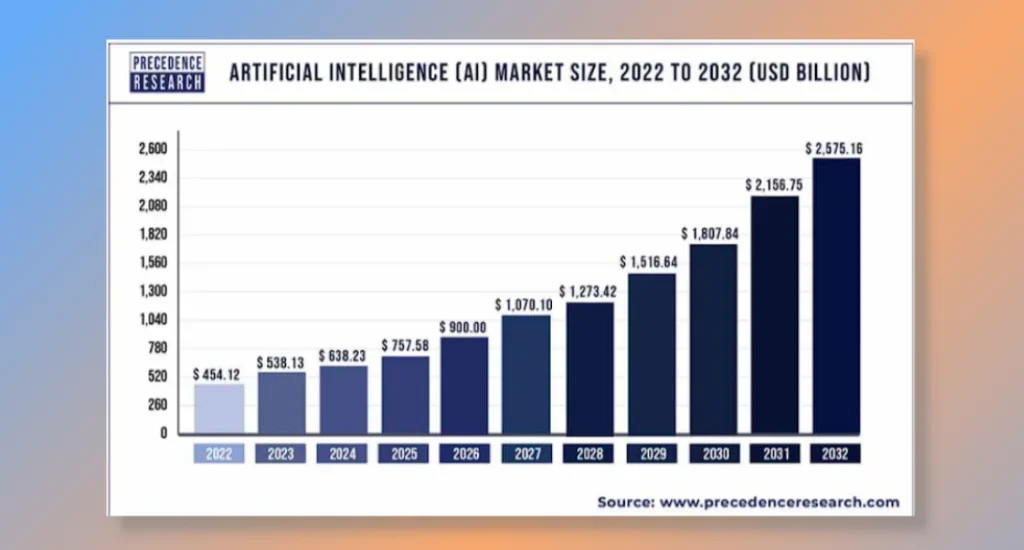
Why Commercialized AI Will Impact the Industry
Commercialized AI is poised to revolutionize the emerging IT industry, offering new avenues for business growth and market expansion. AI technology redefines how companies understand and engage with their target audience by empowering businesses to provide enhanced customer data analytics and insights.
The surge of new applications and use cases driven by commercialized AI creates a competitive edge in the market, fostering innovation in product development and business processes. As businesses leverage AI-generated insights, they are better equipped to make informed decisions and stay ahead of the curve in an increasingly competitive landscape.
Trend 2: Sustainability in Technology
Sustainability in technology has become a key focus for many companies. Prioritizing environmental responsibility involves reducing energy consumption, minimizing waste, and utilizing renewable resources. Besides benefiting the planet, sustainable practices can save costs and enhance brand reputation.
Based on the KBV Research report, the global green technology and sustainability market is projected to expand substantially within the emerging IT industry, with an anticipated market size of $38.15 billion by 2027. This growth represents a remarkable compound annual growth rate (CAGR) of 22.5% throughout the forecast period.
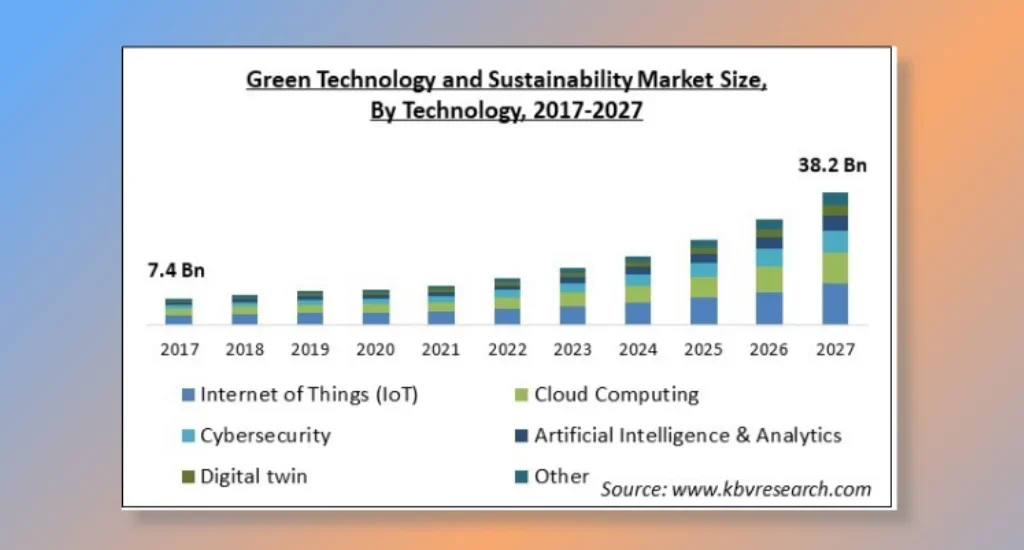
Why Sustainability in Technology Will Impact the Industry
Sustainable technology practices contribute to environmental conservation, fostering innovation in renewable energy sources and reducing the carbon footprint. Embracing sustainability aligns with corporate social responsibility while leading to cost savings and operational efficiency.
Moreover, sustainable technology promotes a healthier and greener future, shaping software development and data center management in the coming years. As companies focus on sustainability, incorporating these practices into their operations will be critical for long-term success and the convergence of reality and digital.
Trend 3: Real-World Applications for Quantum Computing
Real-world scenarios benefit from the rapid evolution of quantum computing, offering solutions to complex problems. Quantum computing's applications include drug discovery, financial modeling, and cryptography. With the use of qubits, it allows exponentially faster processing than classical computers.
According to the Global Market Insights report, the quantum computing market share within the software segment is poised to exceed $10 billion by 2032, propelled by escalating demand for Software as a Service (SaaS) business models, expanding workloads in data centers, and the evolution of sophisticated processor architectures in traditional binary computing systems.
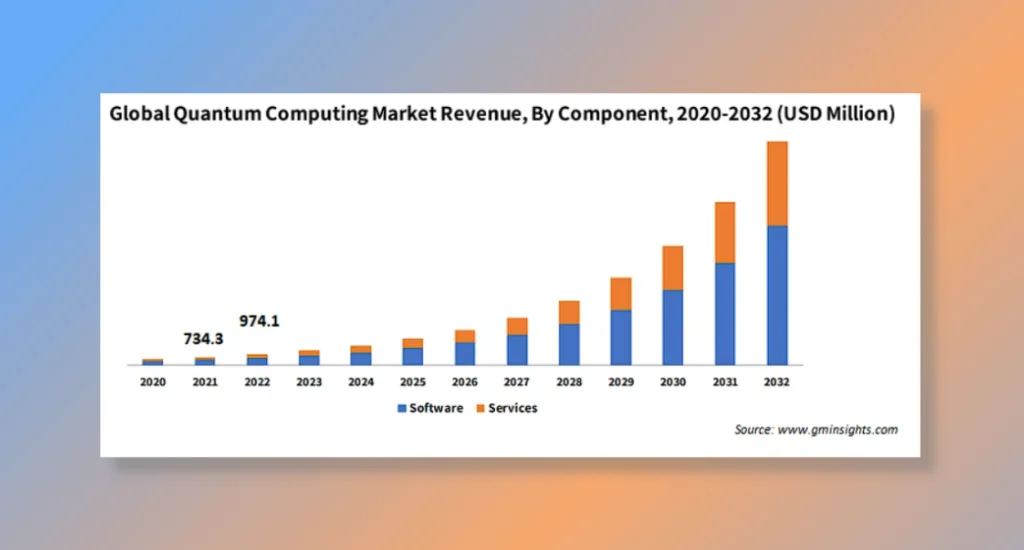
Why Real-World Applications for Quantum Computing Will Impact the Industry
Real-world quantum applications hold the potential to revolutionize multiple industries, including drug discovery and logistical operations, through unprecedented processing power for complex problem-solving.
Quantum computing also offers the ability to optimize data encryption methods and accelerate scientific breakthroughs, impacting IT industry advancements in the coming years. The practical applications of quantum computing are set to transform software development and data centers, enabling innovative solutions utilizing generative AI and natural language processing.
Trend 4: Increased Security from Cyber Threats
Advanced security measures play a crucial role in safeguarding against ever-evolving cyber threats, ensuring the resilience of digital infrastructures. The integration of cyber threat intelligence enables proactive detection and mitigation of potential risks, strengthening the overall security posture.
Based on the Market.US report, the global cybersecurity market suggests a robust growth trajectory, with an anticipated value of approximately $533.9 billion by 2032. This projection marks a significant increase from its 2023 valuation of $193 Billion, indicating a compelling Compound Annual Growth Rate (CAGR) of 11% from 2022 to 2032.
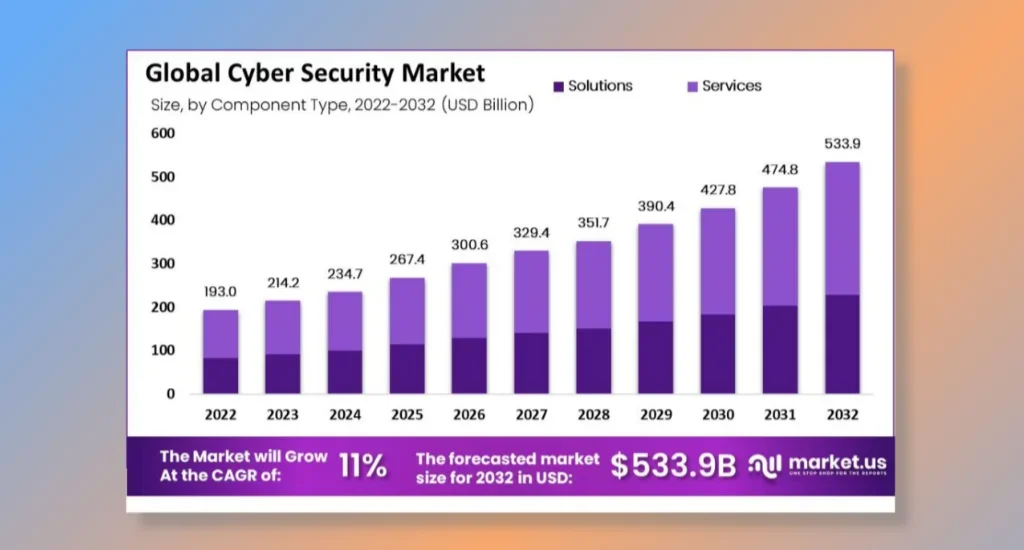
Why Increased Security from Cyber Threats Will Impact the Industry
Advanced security measures play a crucial role in safeguarding against the ever-evolving cyber threats, ensuring the resilience of digital infrastructures. The integration of cyber threat intelligence enables proactive detection and mitigation of potential risks, strengthening the overall security posture.
Moreover, implementing enhanced security protocols fortifies critical digital infrastructures, ensuring the confidentiality and integrity of sensitive data, including financial information vulnerable to credit risk. As the IT industry faces diverse cyber threats, robust security measures will be pivotal in ensuring the integrity of digital operations in the coming years.
Trend 5: Data-Driven Design and Development
Data-driven design and development harnesses data to optimize products and services, leveraging insights from user behavior analysis for informed decision-making. This strategy mitigates risks, improves product quality, and enhances user experiences, necessitating data analytics, visualization, and modeling expertise.
According to the Business Research Insights report, the global UX service market is expected to hit $48,931.58 million by 2031, with a notable CAGR of 37.8%. This highlights the importance of data-driven design and development in IT, as companies focus on improving user experiences with more investment in UX services.
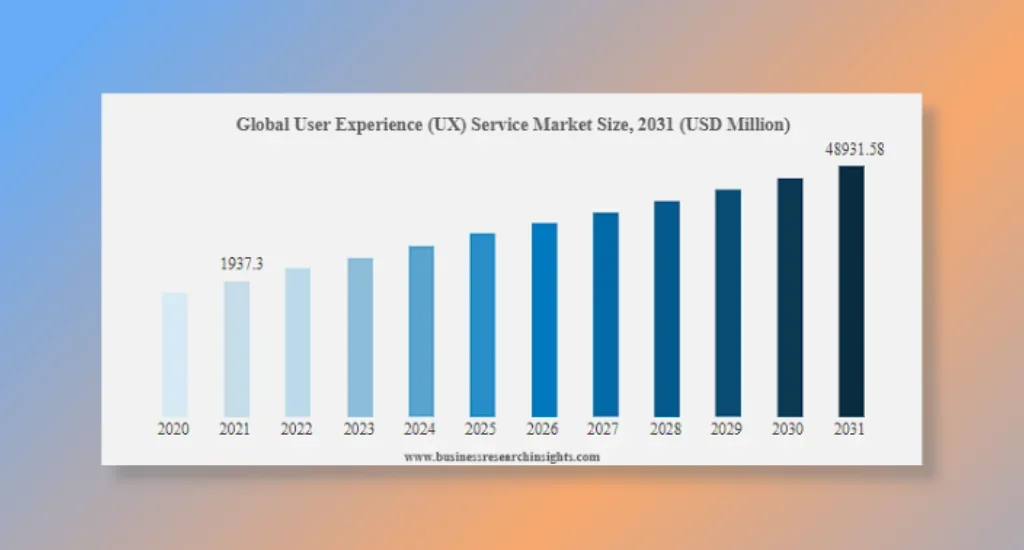
Why Data-Driven Design and Development Will Impact the Industry
Data-driven design and development in the IT industry ensures optimal resource allocation and utilization, driving informed decision-making and product development through data analytics. By leveraging data insights, businesses can enhance user experience, personalize products, and optimize processes, fostering agile and adaptive strategies.
As data continues to play a pivotal role, integrating generative AI, natural language processing, and neuromorphic computing will define the future of software development. Real-world applications of data-driven design will revolutionize customer engagement in the coming years, reshaping the IT landscape.
Trend 6: Convergence of Reality and Digital
The merging of real and digital worlds, combining virtual and augmented reality technologies with actual environments to create immersive experiences, is an increasingly popular trend in the IT industry. This convergence has diverse gaming, education, and healthcare applications, offering businesses new opportunities to engage with customers.
Grandview Research said the global mixed reality market was valued at $38.15 million in 2015. The mixed reality hardware segment is expected to grow at a CAGR of over 76.8% from 2016 to 2024, indicating the fast-paced adoption and expansion of mixed reality technologies in the IT industry.
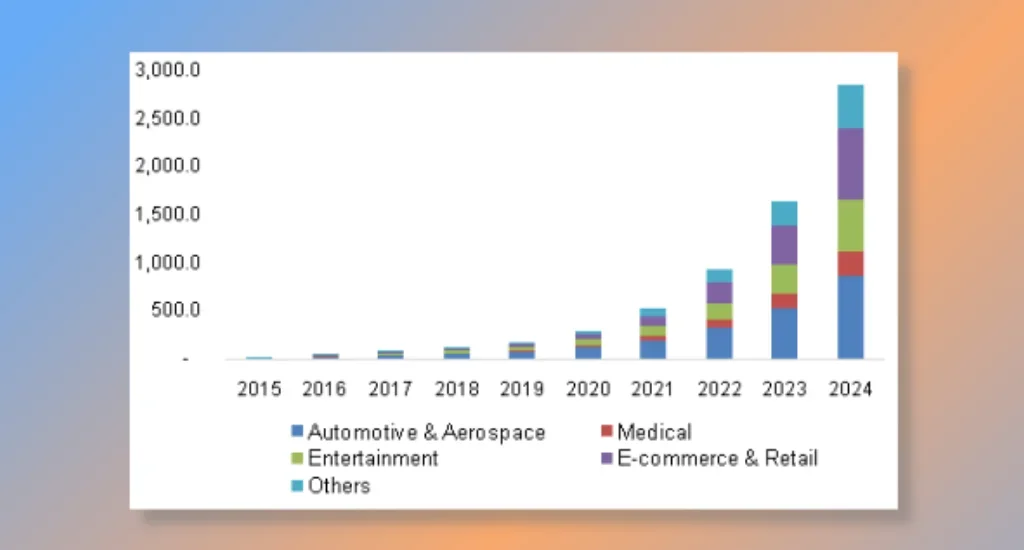
Why Convergence of Reality and Digital Will Impact the Industry
The fusion of reality and digital tech leads to immersive experiences, expanding virtual reality (VR) applications by integrating physical and digital realms. This convergence boosts augmented reality innovation, improving customer interaction. It also creates new market chances, fostering innovation in the IT industry and changing user interaction and experience.
This convergence will further shape software development, data center technologies, and real-world applications in the upcoming years. This evolution will drive the need for generative AI, neuromorphic computing, and innovative solutions to accommodate the expanding presence of the Internet of Things (IoT).
Trend 7: Continuous Rise of Platform Engineering
The growing significance of platform engineering in the IT sector is undeniable. Businesses are increasingly relying on platform engineering to maintain their competitiveness. This involves the creation of platforms that facilitate the development, deployment, and management of software applications.
According to a Global Market Insights report, the DevOps market surpassed $8 billion in 2022 and is expected to grow by 20% annually from 2023 to 2032. This growth is fueled by the increasing need to shorten software development cycles, highlighting the importance of platform engineering in improving development processes and operational efficiency in IT.
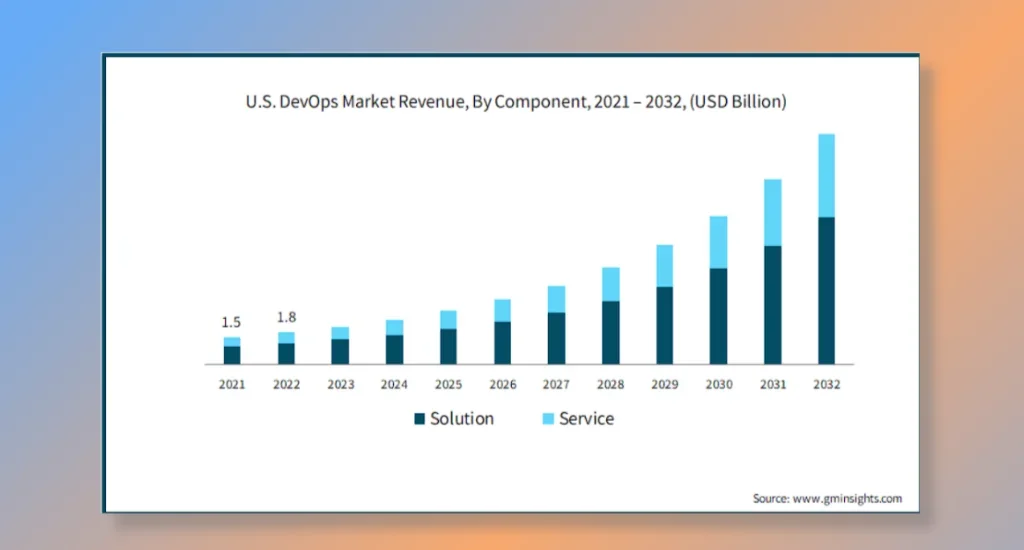
Why the Continuous Rise of Platform Engineering Will Impact the Industry
The continuous rise of platform engineering is reshaping the IT industry by enabling businesses to develop and manage software applications efficiently. This trend is driven by the increasing adoption of cloud computing and DevOps practices, creating a demand for platform engineering skills. As a result, new job roles and career paths are emerging in the IT industry.
Platform engineering enhances user experience, reduces costs, and accelerates market entry. With the increasing demand to stay relevant amid evolving trends, continuous education is vital for IT professionals to shape the emerging IT industry, optimizing software development and fostering growth.
How to Stay Ahead of the Curve in Emerging Information Technology Trends
It's imperative to proactively grasp the latest innovations and strategies to maintain a leading edge in emerging information technology trends. By embracing these advancements, you can thrive amidst evolving IT landscapes. Here are key insights to help you stay ahead and succeed in the world of information technology:
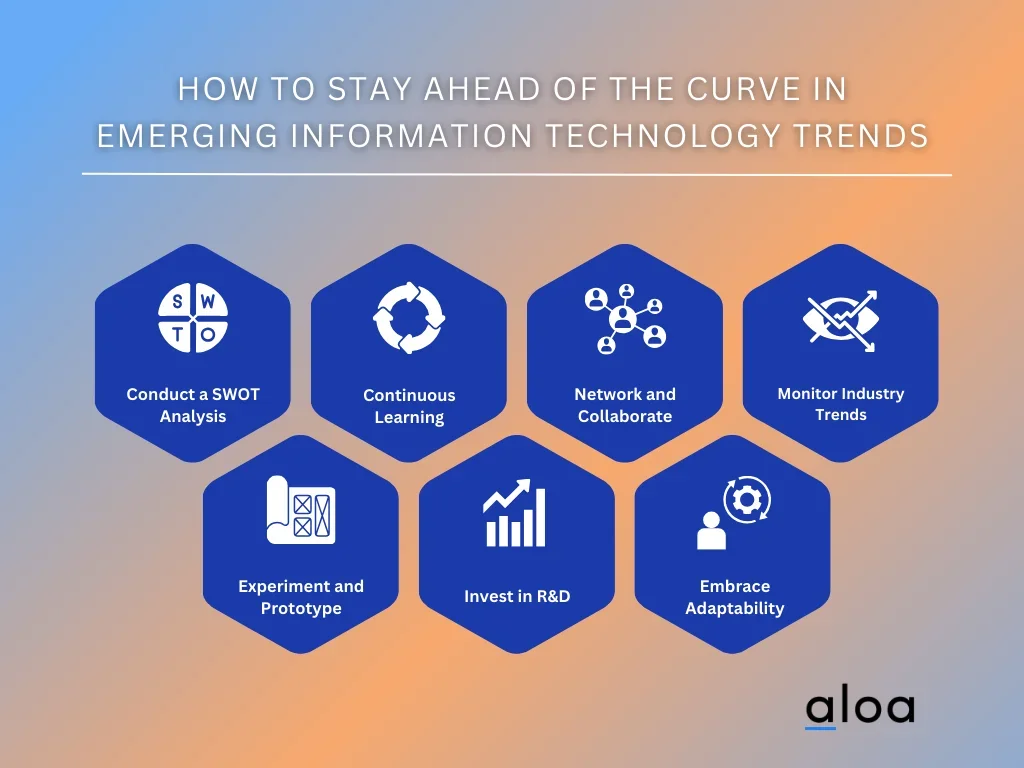
Conduct a SWOT Analysis
Conducting a SWOT analysis involves comprehensively assessing your organization's internal strengths and weaknesses and external opportunities and threats. This analysis helps you identify areas where you excel, areas that need improvement, potential avenues for growth, and external factors that could pose challenges.
By understanding these aspects, you can develop strategies to capitalize on strengths, address weaknesses, seize opportunities, and mitigate threats effectively. When conducting a SWOT analysis to assess information technology, several factors require consideration, including:
- Industry Trends: Analyze broader industry trends and dynamics that could influence your organization's position and prospects. Consider factors such as market growth rates, industry consolidation, disruptive innovations, and changes in customer preferences.
- Market Positioning: Assess your organization's current market position relative to competitors. Understand your market share, brand perception, distribution channels, customer loyalty, and pricing strategies.
- Customer Insights: Gain insights into customer needs, preferences, and buying behavior. Understand what drives customer satisfaction, loyalty, and retention and where your products or services may fall short.
- Financial Performance: Evaluate your organization's financial health and performance metrics. 409A valuation services consider revenue growth, profit margins, return on investment, cash flow, and debt levels.
- Resource Allocation: Assess how effectively resources such as human capital, technology, and capital are allocated within your organization. Identify areas where resource allocation could be optimized to improve efficiency and effectiveness.
- Risk Management: Identify and prioritize risks that could impact your organization's ability to achieve its objectives. Develop strategies to mitigate these risks and build resilience against potential threats.
Engage in Continuous Learning and Education
Stay updated with emerging information technology developments by actively participating in courses, workshops, webinars, and relevant certifications to enhance your skill set. Networking with peers and industry experts offers insights and new learning possibilities, contributing to career advancement.
In addition, embracing a growth mindset and being open to new ideas is pivotal for keeping pace with the ever-evolving information technology landscape. By actively participating in ongoing education and skill development, professionals equip themselves with the knowledge and expertise needed to thrive in the rapidly changing tech industry.
Build Networks and Collaborate
Establish connections with professionals in the emerging IT industry through networking events, online forums, and social media platforms. Networking facilitates the exchange of knowledge and experiences among professionals, fostering a conducive environment for growth and learning.
Collaboration with diverse peers can yield fresh perspectives and innovative ideas, propelling technological advancements. Active involvement in professional associations and attending industry gatherings can significantly expand one's network. Embracing continuous learning and development is even more pivotal for remaining at the forefront of emerging technological advancements.
Monitor Industry Trends
Staying informed about emerging technologies and their potential impact on the industry is crucial. Subscribe to industry publications, attend conferences, and network with experts to gain valuable insights. Monitoring trends in cybersecurity, cloud computing, artificial intelligence, and data analytics further identify opportunities for innovation.
Additionally, leveraging market research and competitive analysis can help recognize growth areas. Encouraging a culture of innovation and keeping employees updated on emerging information technology trends is vital for staying ahead.
Experiment and Prototype
Experimentation and prototyping play a pivotal role in the tech industry, enabling the testing of new technologies without immediate full-scale deployment. Rapid iteration and feedback refine ideas, identifying potential issues and limitations.
Moreover, experimentation can bring to light new market opportunities and ways to enhance business operations. Prototyping allows for early user feedback, helping gauge interest and identify potential customer needs. When considering experimentation and prototyping in the tech industry, several factors come into play:
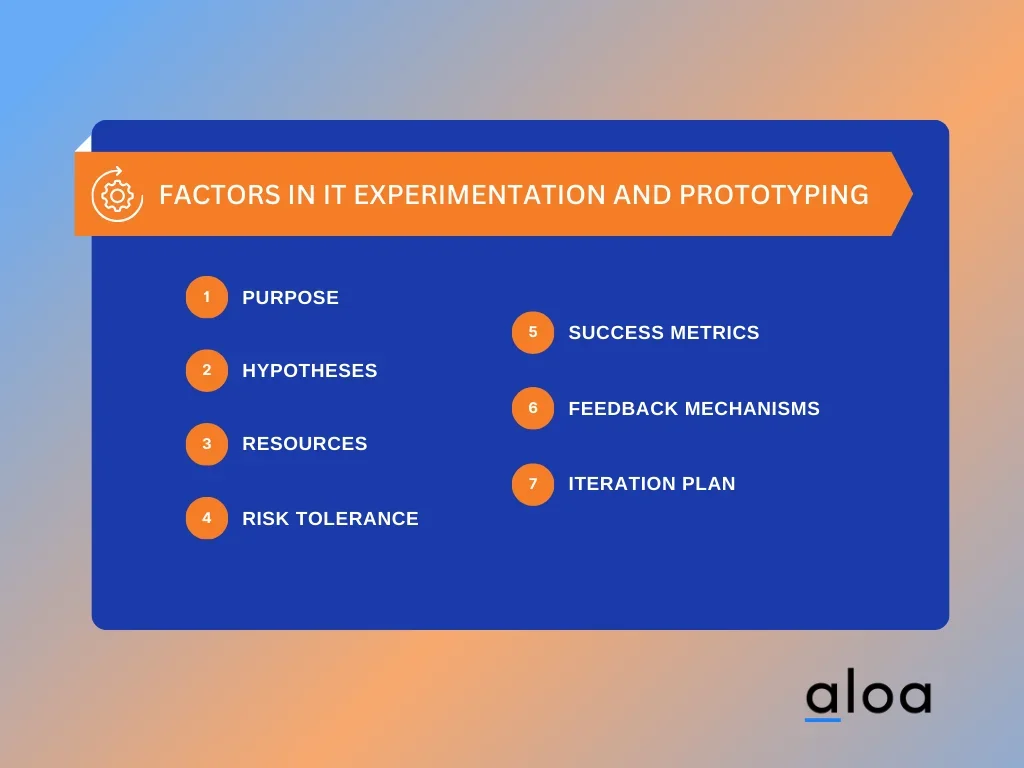
- Purpose: Clearly define the purpose of the experiment or prototype. Is it to test a new technology, explore a market opportunity, or improve business operations?
- Hypotheses: Clearly articulate the hypotheses you aim to test through experimentation or prototyping. What assumptions are you making, and how will you validate or invalidate them?
- Resources: Assess the resources required for conducting the experiment or building the prototype. This includes time, money, personnel, and materials.
- Risk Tolerance: Understand the level of risk the organization is willing to take with the experiment or prototype. Balancing risk with potential rewards is crucial.
- Success Metrics: Define clear success metrics to measure the effectiveness of the experiment or prototype. This could include user engagement, cost savings, revenue generation, or other relevant Key Performance Indicators (KPIs).
- Feedback Mechanisms: Establish mechanisms for collecting feedback from users, stakeholders, and team members throughout the experimentation or prototyping process. Feedback loops are essential for iterative improvement.
- Iteration Plan: Develop a plan for iterating on the experiment or prototype based on feedback and insights gained. Rapid iteration allows for continuous improvement and adaptation.
Invest in Research and Development
Investing in research and development (R&D) is crucial for companies looking to maintain a competitive edge in the emerging information technology landscape. R&D investments enable companies to delve into cutting-edge technologies, fostering the creation of innovative solutions that can propel them ahead of the competition.
Furthermore, R&D efforts empower companies to identify new business prospects and revenue streams in emerging IT markets. By prioritizing R&D, companies gain valuable insights into customer needs and preferences, allowing them to align their offerings with market demands and stay ahead of changing industry dynamics.
Embrace Adaptability and Flexibility
Embracing new technologies, processes, and methodologies is essential to staying ahead of the curve. Agile methodologies and continuous learning are critical drivers of innovation and productivity. Remaining open to new ideas and feedback leads to improved problem-solving and decision-making.
In addition, collaboration and communication with cross-functional teams result in better outcomes and enhanced customer satisfaction. Embracing adaptability and flexibility is vital for thriving in the emerging information technology industry, driving growth, and ensuring sustained relevance.
Key Takeaway
Being proactive about emerging information technology trends is crucial for businesses aiming to remain competitive and relevant in this competitive landscape. Incorporating cutting-edge technologies such as artificial intelligence, cloud computing, and IoT can revolutionize business operations, enhance efficiency, and drive innovation.
By adopting these emerging IT trends, businesses can optimize processes, enhance decision-making capabilities, and create personalized customer experiences. From predictive analytics to machine learning algorithms, companies can harness the power of data to gain valuable insights, anticipate market trends, and make informed strategic decisions.
Seize this opportunity to stay ahead of the curve by subscribing to our email list through the Aloa blog page. Receive regular updates on the latest insights and trends in emerging information technology, empowering your business to capitalize on new opportunities, drive innovation, and achieve long-term success in today's dynamic marketplace.

